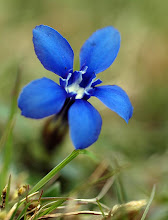You can crudely divide orchids into two groups: ground orchids, rooted in the soil - like Pleione species, for example - and epiphytic orchids like the one below, that often grow on the branches of trees in tropical forests. The dangling roots of the epiphytic types have a dual role, sometimes anchoring the plant and always acting as storage vessels for water that they absorb from mist and sudden tropical downpours. If you cut a section through one of these roots (above) you can see their unique structure, that allows them to absorb and store water. The bright yellow ring of thick-walled cells at the bottom of the image above is the plant's internal plumbing - the pipes (xylem vessels) that conduct water from the roots to the leaves and flowers. Beyond that the thin-walled blue cells are the packing cells that are alive and contain some chloroplasts, like the leaves. Beyond that, sheathing the root and separated by a distinct layer of mostly hexagonal cells is an outer sheath of dead cells called the velamen layer, and their role is to soak up water as the roots dangle in the air, high above the forest floor. They are, in effect, a sponge.
The recommended way to water tropical orchids, like Vanda species for example, is simply to stand them in water for a few minutes each day, so their root velamen layer fills up with water, then simply hang the plants up with their roots dangling in space.
You can see here what happens when you water an orchid root here. When it's dry (above) the dead velamen layer cells reflect light and the whole root looks silvery-white. Make them wet for just a few seconds (below) and those dead cells fill up with water, become translucent and reveal the green photosynthetic tissue within.


















Fascinating and interesting as always, Phil.
ReplyDeleteI love visiting this Blog. It's always fascinating! Your pics are gorgeous!
ReplyDeleteGaby xo
Thanks John, I find the internal architecture of plants fascinating
ReplyDeleteThanks for visiting Gaby, and for the kind comment...
ReplyDeleteI'm an orchid nut and I love these photos! Thank you for posting!!!
ReplyDeleteYou're welcome Monica - thank you for visiting....
ReplyDeleteHaving Just been to the Lovely living rainforest in Newbury, a sanctuary for me, I was explaining all about Epiphytic roots to my Mum, and fell upon this blog, absolutely excellent as I have to teach a unit on botany to my Floristry students, I will make this a favourite site... Thank you....
ReplyDeleteHello Karla, Thanks for visiting - hope your teaching goes well.best regards, Phil
ReplyDelete